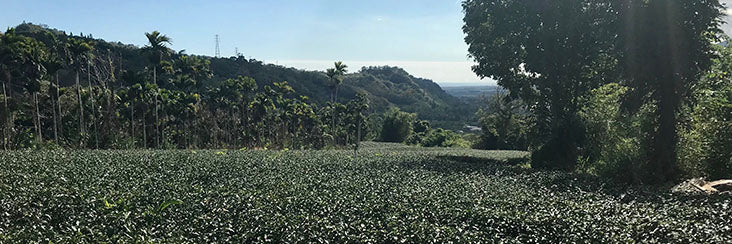
Red Oolong Tea: Gem Of Taiwan's Southeast Coast

The roadside snapshot above shows the sculpture of the Chinese character "cha" (tea) at the Taidong Branch of the Tea Research and Extension Station (TRES). It marks the establishment of the Department of Agriculture's program to develop this rural area on Taiwan's southeast coast as a tea producing region that began decades ago. We stopped to appreciate the old school post-industrial aesthetic of it when Eco-Cha recently visited this area. Behind the landmark we can see tea trees growing naturally (not pruned for cultivation), bordering the tea garden behind them.

We were happily surprised to see organically grown tea flourishing at lower elevations in the foothills of Taiwan's southeast coast, which has a hotter and dryer climate than the more renowned tea regions on the central-western mountain range and in northern Taiwan.

Further into the hills we visited an even more successful development of organically cultivated plots of tea. Above we see Eco-Cha's sourcing director Andy with the farmer looking for Green Leafhoppers, even though it was the middle of January, when the Leafhopper is rarely found in other tea growing regions. The regional climate conditions combined with organic farm management are two fundamental aspects of how this new type of tea known as "Hong Oolong" came to be.

The TRES originally advised tea farmers in this region to process their tea leaves as a tightly rolled variation of Baozhong Oolong, which is a lightly oxidized, unroasted tea that is traditionally produced in northern Taiwan. This processing method proved to be far less than ideal however, as they could only produce quality tea from early spring and late winter harvests, due to the hotter, dryer climate. This sacrificed about 60% of the potential annual yield. So about 10 years ago, the TRES in cooperation with the Luye Farmers' Association redesigned production methods. This innovation involves oxidizing the leaves to at least 80%, using a combination of both Oolong and Black Tea processing techniques. So they decided to name this tea type simply "Hong Oolong" or Red Oolong, as Black Tea in Chinese is called Red Tea.

With the introduction of Red Oolong processing methods, Mr. Lin has transitioned to being certified organic, including his own tea factory that has a 5 star (highest) rating for sanitation. He says that the hotter, drier climate here is conducive to producing this tea type, since higher temperatures during the growing season produce higher levels of catechins in the tea leaves, which result in more bitter/astringent flavors when only lightly oxidized. However, when leaves with high concentrations of catechins are heavily oxidized, they produce a superior quality. Heavily or fully oxidized (Black) Teas are also much more accommodating of natural pests that are an inevitable aspect of organic farming. The extensive processing of the leaves eliminates the difficulties of producing more delicate, greener teas from leaves that have naturally occurring imperfections. This, in short, is the logic behind the invention of Red Oolong Tea.

Red Oolong truly is at the border between being an Oolong and a Black Tea. From the appearance of the brewed leaves and the brewed tea, it looks like a Black Tea. However, given that the leaves have undergone stages of Oolong Tea processing, including a light roasting at the finish, there is an element of Oolong in its character. Add to this the fact that the cultivars used to produce this tea are all within the broad category of "small leaf" as it is termed in Taiwan, basically Oolong Tea strains — to be distinguished from Assam, Red Jade (Tai Cha #18), and the indigenous Mountain Tea (Shan Cha) strains used for Black Tea production.
Red Oolong offers a smooth, balanced, mildly sweet, rich but not quite bold flavor profile, with elements of fruit compote, pumpkin pie, and a hint of dried flowers. This ultra-friendly character, combined with the fact that almost all Red Oolong is cultivated naturally on the southeast coast of Taiwan, facing the wide open Pacific, where the sky reminds a North American of the northern west coast, is no wonder why it is rapidly gaining popularity on the international market. Once again, Taiwan leads the way in Oolong Tea innovation! If you found this interesting, check out our fine selection of Oolong and other teas.

